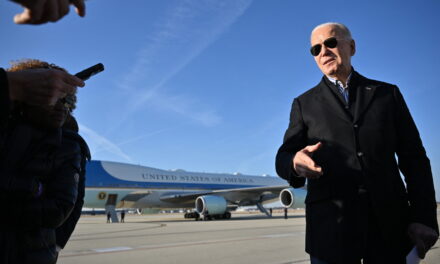
Trump, Lagging in Polls, Tries to Project Strength: This Week in the 2020 Race
Welcome to our weekly analysis of the state of the 2020 campaign.
The week in numbers
-
The Biden campaign has now spent more than $500 million on ads this year. Over the last week, the Biden campaign spent $40.3 million on television and radio, while the Trump campaign spent about $23.3 million, slightly more than the previous week, according to the ad-tracking firm Advertising Analytics. The Trump campaign has closed the spending gap on Facebook, spending $5.2 million on the platform over the past week, while the Biden campaign spent $5.9 million in the same period.
-
The polling picture for President Trump grew particularly dark this week, as it became clear there was no sympathy bump after his positive coronavirus test. A CNN poll found him trailing Joe Biden by 16 points among likely voters nationwide — his worst result of any CNN survey this year.
-
The poll was conducted primarily after Mr. Trump received his virus diagnosis. Sixty-three percent of Americans in that survey said they thought the president had acted irresponsibly toward those around him in handling the threat of infection.
-
A pair of New York Times/Siena College polls out this week found Mr. Biden with a six-point lead in Nevada and a statistically insignificant one-point edge in Ohio, where Mr. Trump won handily four years ago.
Catch me up
With just three weeks to go before Election Day, and voting already underway in many states, President Trump’s support is falling far behind his opponent nationally, with his behavior alienating women, seniors and suburbanites, according to new polls. The president, eager to rejoin the campaign trail after being hospitalized with the coronavirus, secured a doctor’s note clearing him to return to “public engagements” as soon as Saturday. Mr. Trump is planning to host hundreds of people on the South Lawn of the White House that day; it would be his first in-person event since his positive coronavirus test. He has been eager to show that there is no cause for concern when it comes to his health, and no medical reason to hold him back. After the president refused to participate in a virtual debate on Oct. 15, which organizers had proposed as a safety precaution, the Commission on Presidential Debates officially canceled the event.
The problem for Mr. Trump is that his in-person return isn’t necessarily a plus for him, politically. In his aggressive attacks and interruptions during his debate with former Vice President Joseph R. Biden Jr. two weeks ago, the president appeared to only further alienate undecided voters, according to focus groups and polls. The president attempted to show his supporters that everything was fine in two phone interviews on Thursday. But, he called for his political enemies to be indicted and later sounded raspy when he called into Sean Hannity’s show Thursday night. He spent over two hours on the phone with right-wing radio host Rush Limbaugh on Friday, and he wasn’t the one to cut the session off.
His campaign, meanwhile, has become primarily a television ad-buying apparatus, though it is shrinking its television spending as it contends with cash flow issues, as it waits on the White House to figure out when and how the president will return to the trail.
Mike Pence tried to recast Donald Trump at V.P. debate
The first and only 2020 vice-presidential debate was an exercise in avoidance.
As Senator Kamala Harris of California pushed Vice President Mike Pence to defend the policies and tone of Mr. Trump, Mr. Pence sought to recast the president as someone different from the one who many American voters see. In Mr. Pence’s telling, Mr. Trump has taken the threat of the virus seriously from its outset. He ignored questions about how the president has cast doubt on the electoral process and, during the last presidential debate, refused to denounce white supremacy.
The Trump campaign had hoped to capitalize on what they saw as a strong performance by the vice president. But less than 48 hours later, Mr. Trump had already moved the attention back onto himself.
Mr. Trump’s desire to hold campaign rallies next week and the administration’s refusal to answer basic questions about his health overshadowed Mr. Pence’s efforts to put a more empathetic spin on the administration’s coronavirus response.
Everyone got the virus, but no one went off message
In Trumpworld, testing positive for the coronavirus was no reason for the president’s top surrogates and spokesmen to halt their regular appearances on television, the key to relevancy in the president’s universe, or change their talking points about the administration’s response. Kayleigh McEnany, the White House press secretary, has been appearing on Fox News from her home, where she is isolating from the rest of her family.
“This was a novel virus that came in from China,” Ms. McEnany told Mr. Hannity, the Fox News host, this week. “No one had seen it. There were no tests. There were no therapeutics. In short order, President Trump developed them.”
Ronna McDaniel, the chairwoman of the Republican National Committee, appeared on Fox News to criticize the debate commission for “not following the science” by deciding to hold a virtual debate. “The C.D.C. has said you’re not shedding live virus 10 days after diagnosis,” she said, speaking from her home where she, too, is recovering from the virus.
-
Appearing on TV while sick is a way to play down the virus: Surrogates who appear on television even after having tested positive were the living embodiment of the president’s edict, “don’t let it dominate your life.” By appearing on television, those surrogates were embodying the president’s false claim that Covid-19 was akin to contracting the flu.
-
Contracting the virus didn’t change anyone’s view of it: Even as the virus has infected many in the West Wing, the talking points have remained virtually unchanged. If anything, some Trump advisers worried that the president’s rhetoric about the virus had become more dangerous since his own diagnosis, as he has told people the virus was not something to fear. None of the newly infected appeared chastened by the experience of getting the virus, themselves. Even friends of Chris Christie, the former New Jersey governor who has been hospitalized for a week, said he was doing just fine, swatting away any questions about the state of his health.
Why won’t Biden or Harris answer about court packing?
The overarching philosophy of Mr. Biden’s campaign has been to keep the focus on Mr. Trump, and specifically his handling of the pandemic. Because of this both Mr. Biden and his running mate are refusing to answer a basic policy question: are they in favor of adding seats to the Supreme Court?
The Democratic candidates have both said to answer the question would be a distraction during a time Republicans are seeking to push through the Supreme Court nomination of Judge Amy Coney Barrett. Mr. Biden went further this week, saying he intended to tell voters his view on the subject after the November election.
Here are three things you should know about the Democrats and the issue of court packing:
-
Mr. Biden rejected the idea in the primary: Mr. Biden is currently refusing to answer a question that he has already answered. Before the Iowa caucuses, in an interview with Iowa Starting Line, Mr. Biden said court packing would be mistake. “No, I’m not prepared to go on and try to pack the court, because we’ll live to rue that day,” he said at the time.
-
Ms. Harris expressed some openness: Ms. Harris, who did more to court the party’s progressive flank in the primary than Mr. Biden, has previously signaled that she was weighing the idea. When asked in March, Ms. Harris said “We have to take this challenge head on, and everything is on the table to do that.” Ms. Harris said there was a “crisis of confidence” on the court that Democrats have to address.
-
The politics are unclear: Some progressive groups have pushed elected officials to answer the question of expanding the courts but it is unclear whether the issue has permeated to the Democratic base. In the short term, Democrats are seeking to push back on Republican attempts to confirm Ms. Barrett for the seat once held by Justice Ruth Bader Ginsburg. Democrats want to correct what they feel was a “stolen” seat when President Barack Obama was blocked from filling the open seat after Justice Antonin Scalia died in 2016. Instead, it was filled by Mr. Trump who nominated Justice Neil Gorsuch. At this point, it is a Washington power play, not a clear electoral issue.
What you might have missed
-
The R.N.C. invested $60 million in a digital get-out-the vote campaign this year. That’s a $57.1 million jump from 2016, emphasizing that the party recognizes mail-in voting is a necessary push even if the president doesn’t think so.
-
Mr. Trump has counted on veterans as well as active-duty service members as a key slice of his political base; in 2016, about 60 percent voted for him. But that support appears to have slipped. Mr. Trump’s comments this week suggesting Gold Star families were to blame for his coronavirus infection aren’t helping.
-
In an effort to avoid another 2016, when Facebook was used by Russian operatives to spread misinformation before the election, Mark Zuckerberg has spent more than $5.1 billion this year on the company’s “integrity” and security divisions, which identify and clamp down on interference. This is more than Facebook’s yearly revenue in 2012.
Nick Corasaniti, Isabella Grullón Paz and Giovanni Russonello contributed reporting.

















